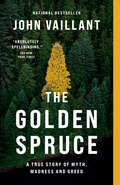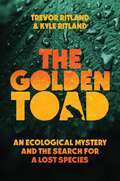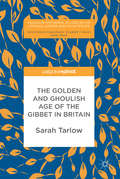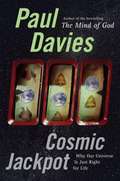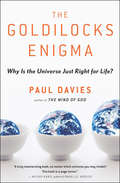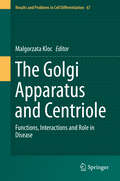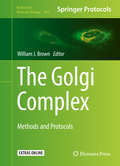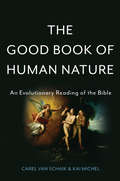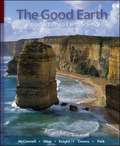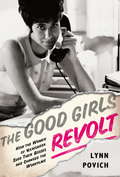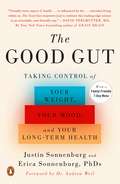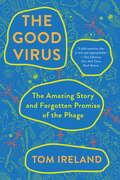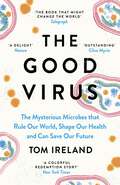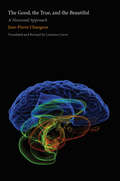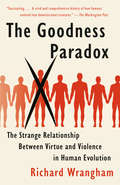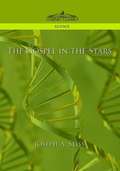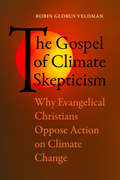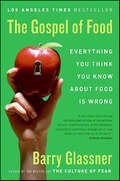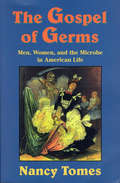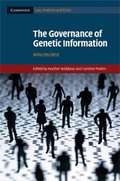- Table View
- List View
The Golden Spruce: A True Story of Myth, Madness and Greed
by John VaillantNATIONAL BESTSELLER • WINNER OF THE GOVERNOR GENERAL'S LITERARY AWARD FOR NON-FICTION • WINNER OF THE WRITERS&’ TRUST NON-FICTION PRIZE&“Absolutely spellbinding.&” —The New York TimesThe environmental true-crime story of a glorious natural wonder, the man who destroyed it, and the fascinating, troubling context in which this act took place. FEATURING A NEW AFTERWORD BY THE AUTHOROn a winter night in 1997, a British Columbia timber scout named Grant Hadwin committed an act of shocking violence in the mythic Queen Charlotte Islands. His victim was legendary: a unique 300-year-old Sitka spruce tree, fifty metres tall and covered with luminous golden needles. In a bizarre environmental protest, Hadwin attacked the tree with a chainsaw. Two days later, it fell, horrifying an entire community. Not only was the golden spruce a scientific marvel and a tourist attraction, it was sacred to the Haida people and beloved by local loggers. Shortly after confessing to the crime, Hadwin disappeared under suspicious circumstances and is missing to this day. As John Vaillant deftly braids together the strands of this thrilling mystery, he brings to life the ancient beauty of the coastal wilderness, the historical collision of Europeans and the Haida, and the harrowing world of logging—the most dangerous land-based job in North America.
The Golden Toad: An Ecological Mystery and the Search for a Lost Species
by Trevor Ritland Kyle RitlandThe Costa Rican cloud forest, a mysterious amphibian killer, and a vanished species: with support from Leonardo DiCaprio&’s Re:wild campaign, twin documentarians and environmental writers follow their father&’s footsteps into the heart of the modern extinction crisis. As young boys, Trevor and Kyle Ritland were fascinated by the magnificent golden toad of Costa Rica, a brilliant species their biologist father showed them in his projector&’s slide shows. Native to only one wind-battered ridgeline high on the continental divide above the cloud forests of Monteverde, thousands of golden toads would congregate for a few weeks each year in ephemeral pools among the twisted roots to mate, deposit their offspring, and retreat again beneath the earth. But from one year to the next, the toads disappeared without a trace; the last of them vanished more than thirty years ago. Since then, only rumors remain—alleged sightings by local residents, which beg the question: could the golden toad still be alive? In The Golden Toad, Trevor and Kyle set off to investigate an environmental mystery with unexpected revelations, a story that speaks to our own collective and uncertain future. Guided by Costa Rican naturalists—including the last person to have seen the golden toad alive—Trevor searches for survivors while Kyle hunts the killer, and their paths lead them through an imperiled forest, a deadly pandemic, and a changing climate, finally intertwining at the site of the golden toad&’s last emergence deep in Monteverde&’s Bosque Eterno de Los Niños. The toad&’s demise becomes a haunting foretelling of approaching ecological crisis, but with a gold lining on the horizon. The Golden Toad changes the conversation around extinction, climate change, and conservation while exploring environmental grief, resurrection, and hope in a changing world.
The Golden and Ghoulish Age of the Gibbet in Britain (Palgrave Historical Studies in the Criminal Corpse and its Afterlife)
by Sarah TarlowThis book is open access under a CC BY 4.0 licence. This book is the first academic study of the post-mortem practice of gibbeting (‘hanging in chains’), since the nineteenth century. Gibbeting involved placing the executed body of a malefactor in an iron cage and suspending it from a tall post. A body might remain in the gibbet for many decades, while it gradually fell to pieces. Hanging in chains was a very different sort of post-mortem punishment from anatomical dissection, although the two were equal alternatives in the eyes of the law. Where dissection obliterated and de-individualised the body, hanging in chains made it monumental and rooted it in the landscape, adding to personal notoriety. Focusing particularly on the period 1752-1832, this book provides a summary of the historical evidence, the factual history of gibbetting which explores the locations of gibbets, the material technologies involved in hanging in chains, and the actual process from erection to eventual collapse. It also considers the meanings, effects and legacy of this gruesome practice.
The Goldilocks Enigma: Why Is the Universe Just Right for Life?
by Paul DaviesPeople have long gazed in wonder at the universe and asked, Why are we here? Until recently, the answer has been the province of priests and philosophers, but now scientists are starting to weigh in with ideas that are both surprising and deeply controversial. In his new book, physicist Paul Davies shows how recent scientific discoveries point to a perplexing fact: many basic features of the physical universe-- from the speed of light to the most humble carbon atom-- seem tailor-made to produce life. A radical new theory says it's because our universe is just one of an infinite number of universes, each one slightly different. Our universe is bio-friendly by accident; we just happened to win the cosmic jackpot. While this multiverse theory is compelling, it has bizarre implications, from infinite copies of each of us to Matrix-like simulated universes. Davies believes there's a more satisfying solution to the question of existence: the observations we make today could help shape the nature of reality in the remote past. If this is true, then life and, ultimately, consciousness aren't just incidental byproducts of nature, but central players in the formation of the universe.
The Goldilocks Enigma: Why Is the Universe Just Right for Life?
by Paul DaviesThe Goldilocks Enigma is Paul Davies’s eagerly awaited return to cosmology, the successor to his critically acclaimed bestseller The Mind of God. Here he tackles all the "big questions," including the biggest of them all: Why does the universe seem so well adapted for life? In his characteristically clear and elegant style, Davies shows how recent scientific discoveries point to a perplexing fact: many different aspects of the cosmos, from the properties of the humble carbon atom to the speed of light, seem tailor-made to produce life. A radical new theory says it’s because our universe is just one of an infinite number of universes, each one slightly different. Our universe is bio-friendly by accident -- we just happened to win the cosmic jackpot. While this "multiverse" theory is compelling, it has bizarre implications, such as the existence of infinite copies of each of us and Matrix-like simulated universes. And it still leaves a lot unexplained. Davies believes there’s a more satisfying solution to the problem of existence: the observations we make today could help shape the nature of reality in the remote past. If this is true, then life -- and, ultimately, consciousness -- aren’t just incidental byproducts of nature, but central players in the evolution of the universe. Whether he’s elucidating dark matter or dark energy, M-theory or the multiverse, Davies brings the leading edge of science into sharp focus, provoking us to think about the cosmos and our place within it in new and thrilling ways.
The Golem: What Everyone Should Know About Science
by Harry Collins Trevor PinchScience, it would seem, is neither all good nor all bad. It gives us nuclear accidents and cures for disease, agricultural self-sufficiency and death in space flight. Harry Collins and Trevor Pinch liken science to the Golem, a creature from Jewish mythology, powerful yet potentially dangerous, a gentle, helpful creature that may yet run amok at any moment. Through a series of intriguing case studies of famous and not-so-famous scientific episodes, ranging from relativity and cold fusion to memory in worms and the sex lives of lizards, the authors debunk the idea that science is the straightforward result of competent theorisation, observation and experimentation. Closer to the truth, they suggest, is the realisation that scientific certainty comes from interpreting ambiguous results within an order imposed by scientists themselves. This thought-provoking account will give general readers a new perspective on the place of science in society. '. . . perverse but entertaining . . . the writing is deft, the stories are good and there is not a boring page. ' Nature '. . . a must for every science student. ' Science Reporter
The Golgi Apparatus and Centriole: Functions, Interactions and Role in Disease (Results and Problems in Cell Differentiation #67)
by Malgorzata KlocThis volume takes a closer look how the cell organelles Golgi apparatus (also known as the Golgi complex or Golgi body), and centriole are structurally and functionally intertwined.Initially, it was believed that the role of Golgi complex is limited to the packaging and preparation for secretion of various cellular proteins, while the centriole participates in cell division and cilia formation. However, since their discovery nearly 200 years ago, it became clear that these two organelles are interacting, and that their functions are much more complex and far reaching than previously thought. Recent findings indicate that the Golgi–Centriole relationship may be important for directional protein transport, cell polarization and cell cycle progression. Current studies indicate that Golgi and centriole also participate in development and act as cellular and immunological sensors, and that their abnormalities lead to cell and developmental abnormalities, Alzheimer, cancer, various lipid disorders and neurological and immunological diseases in humans. This volume combines the latest information on the structure, molecular composition, and roles of Golgi and centriole in various cellular functions and diseases. The better understanding of the Golgi–centriole interactions may lead to the development of novel therapies for the treatment of various diseases, including cancer.
The Golgi Complex
by William J. BrownFocusing on new methods and techniques developed to address longstanding questions about the Golgi complex, this volume explores a diverse set of chapters, ranging from live and fixed cell imaging techniques to in vitro biochemical reconstitution systems. Each chapter provides a detailed set of specific instructions, which should enable anyone to successfully complete the assays. Written for the highly successful Methods in Molecular Biology series program, chapters include brief introductions to their respective topics, lists of the necessary materials and reagents, step-by-step, readily reproducible laboratory protocols, and tips from the experts on troubleshooting and avoiding known pitfalls. Practical and detailed, The Golgi Complex: Methods and Protocols will aid both new and established researchers in the field by providing strong hands-on instructions that can be directly applied to their research programs.
The Good Book of Human Nature: An Evolutionary Reading of the Bible
by Carel Van Schaik Kai MichelHow reading the Bible as a work of cultural and scientific evolution can reveal new truths about how our species conquered the Earth
The Good Cat Parent’s Guide to Feline Behavior Modification
by Alana Linsay StevensonCats are cuddly and adorable, but they are often misunderstood. Sadly, many cats are relinquished to shelters or rehomed due to normal behaviors that are incorrectly treated or mishandled. In this book, Elite Fear-Free and Low-Stress Handling Certified author Alana Linsay Stevenson empowers cat parents and teaches them how to address and modify challenging feline behavior.You will begin by learning basic kitten care and feline developmental stages; how cats differ behaviorally from group animals, such as dogs and people; feline body language; and how cats handle stress. Alana provides concise instruction on how to gently handle cats: how to pick up and carry them, acclimate them to carriers, the use of towels, alternatives to scruffing, and how our body language affects cats. Packed with photographs for visual reference, this book offers clear guidelines and easily implementable strategies for resolving feline behavioral problems, such as: failure to use the litter box play aggression petting aggression inter-cat aggression furniture scratching jumping on counters obsessing about food night wailing fear of people aggression to strangers The content is organized by topic for easy access to information, as you need it.The Good Cat Parent’s Guide to Feline Behavior Modification is for anyone who likes cats and wants to learn more about them. Whether you are a veterinary professional, a volunteer or shelter worker who regularly handles stressed cats, or a cat parent who simply wants to understand your cat, you will find helpful and useful information at your fingertips to give cats a better quality of life. No cat parent should be without this book!
The Good Earth
by David Mcconnell David Steer Catharine Knight Katharine Owens Lisa ParkThe Good Earth covers the primary topics included in other earth science texts. However, there are a few notable differences in its content compared to other textbooks. The Good Earth begins with an introduction (Chapter 1), then takes up the topic of astronomy (Chapters 2, 3), and moves on to solid earth (Chapters 4, 5, 6, 7, 8), and the processes (Chapters 9, 10, 11, 12), which overlap with the hydrosphere (Chapters 11, 12, 13), before dealing with the atmosphere (Chapters 14, 15, 16), and finishing with a wrap-up chapter on global change (Chapter 17) that incorporates elements of all the previous chapters. This text also includes interesting examples from recent events in relation to near-Earth asteroids, earthquakes, tsunamis, rockfalls, floods, and climate change.
The Good Girls Revolt: How the Women of Newsweek Sued their Bosses and Changed the Workplace
by Lynn PovichIt was the 1960s - - a time of economic boom and social strife. Young women poured into the workplace, but the 'Help Wanted' ads were segregated by gender and the 'Mad Men' office culture was rife with sexual stereotyping and discrimination. <P><P>Lynn Povich was one of the lucky ones, landing a job at Newsweek, renowned for its cutting-edge coverage of civil rights and the 'Swinging Sixties. ' Nora Ephron, Jane Bryant Quinn, Ellen Goodman, and Susan Brown miller all started there as well. It was a top-notch job - - for a girl - - at an exciting place. But it was a dead end. Women researchers sometimes became reporters, rarely writers, and never editors. Any aspiring female journalist was told, 'If you want to be a writer, go somewhere else. ' On March 16, 1970, the day Newsweek published a cover story on the fledgling feminist movement entitled 'Women in Revolt,' forty-six Newsweek women charged the magazine with discrimination in hiring and promotion. It was the first female class action lawsuit - - the first by women journalists - - and it inspired other women in the media to quickly follow suit. <P><P> Lynn Povich was one of the ringleaders. In The Good Girls Revolt, she evocatively tells the story of this dramatic turning point through the lives of several participants. With warmth, humor, and perspective, she shows how personal experiences and cultural shifts led a group of well-mannered, largely apolitical women, raised in the 1940s and 1950s, to challenge their bosses - - and what happened after they did. For many, filing the suit was a radicalizing act that empowered them to 'find themselves' and fight back. Others lost their way amid opportunities, pressures, discouragements, and hostilities they weren't prepared to navigate. <P><P> The Good Girls Revolt also explores why changes in the law didn't solve everything. Through the lives of young female journalists at Newsweek today, Lynn Povich shows what has - - and hasn't - - changed in the workplace.
The Good Gut: Taking Control of Your Weight, Your Mood, and Your Long-term Health
by Andrew Weil Erica Sonnenburg Justin SonnenburgThe groundbreaking science behind the surprising source of good health Stanford University's Justin and Erica Sonnenburg are pioneers in the most exciting and potentially transformative field in the entire realm of human health and wellness, the study of the relationship between our bodies and the trillions of organisms representing thousands of species to which our bodies play host, the microbes that we collectively call the microbiota. The microbiota interacts with our bodies in a number of powerful ways; the Sonnenburgs argue that it determines in no small part whether we're sick or healthy, fit or obese, sunny or moody. The microbiota has always been with us, and in fact has coevolved with humans, entwining its functions with ours so deeply, the Sonnenburgs show us, humans are really composite organisms having both microbial and human parts. But now, they argue, because of changes to diet, antibiotic over-use, and over-sterilization, our gut microbiota is facing a "mass extinction event," which is causing our bodies to go haywire, and may be behind the mysterious spike in some of our most troubling modern afflictions, from food allergies to autism, cancer to depression. It doesn't have to be this way. The Good Gut offers a new plan for health that focuses on how to nourish your microbiota, including recipes and a menu plan. In this groundbreaking work, the Sonnenburgs show how we can keep our microbiota off the endangered species list and how we can strengthen the community that inhabits our gut and thereby improve our own health. The answer is unique for each of us, and it changes as you age. In this important and timely investigation, the Sonnenburgs look at safe alternatives to antibiotics; dietary and lifestyle choices to encourage microbial health; the management of the aging microbiota; and the nourishment of your own individual microbiome. Caring for our gut microbes may be the most important health choice we can make.From the Hardcover edition.
The Good Parenting Food Guide: Managing What Children Eat Without Making Food a Problem
by Jane OgdenThe Good Parenting Food Guide offers straightforward advice for how to encourage children to develop a healthy, unproblematic approach to eating. Explores key aspects of children’s eating behavior, including how children learn to like food, the role of food in their life and how habits are formed and can be changed Discusses common problems with children’s diets, including picky eating, under-eating, overeating, obesity, eating disorders and how to deal with a child who is critical of how they look Turns current research and data into practical tips Filled with practical solutions, take home points, drawings, and photos Mumsnet Blue Badge Award Winner
The Good Virus: The Amazing Story and Forgotten Promise of the Phage
by Tom IrelandA New York Times Editors’ Choice “A deft narrative that is rich and approachable.” —Alex Johnson, New York Times Book Review How a mysterious, super-powerful—yet long-neglected—microbe rules our world and can rescue our health in the age of antibiotic resistance. At every moment, within our bodies and all around us, trillions of microscopic combatants are waging a war that shapes our health and life on Earth. Countless times per second, viruses known as phages attack and destroy bacteria while leaving all other life forms, including us, unscathed. Vastly outnumbering the viruses that do us harm, phages power ecosystems, drive evolutionary innovation, and harbor a remarkable capacity to heal life-threatening infections when conventional antibiotics fail. Yet most of us have never heard of them, thinking of viruses only as enemies to be feared. The Good Virus prompts us to reconsider, and to discover, how these viruses could save countless lives if we can learn to harness their extraordinary abilities. Taking us inside the ongoing quest to use phages’ powers for good, Tom Ireland introduces us to the brilliant, often eccentric, scientists who have fought to realize phages’ potential in the face of doubt and political intrigue. We meet the renegade French-Canadian scientist who discovered phages and pioneered their use as medicine over a century ago, leading them to be hailed as the world’s first genuine antibiotic years before penicillin. We learn why, in some pockets of the former Soviet Union, drinking a vial of phages remains as common as taking an over-the-counter drug. We follow the intrepid scientists and doctors now racing to make “phage therapy” work worldwide as the threat of antibiotic-resistant bacteria grows ever more urgent—even as other researchers uncover how phages bolster our everyday immunity, help generate the oxygen we breathe, and furnish the origins for breakthrough technologies like CRISPR. Unveiling the hidden rulers of the microbial world and celebrating the surprising power of viruses to heal, not harm, The Good Virus forever changes how we see nature’s most maligned life forms.
The Good Virus: The Untold Story of Phages: The Most Abundant Life Forms on Earth and What They Can Do For Us
by Tom IrelandThe untold story of the most abundant life form on Earth, bacteriophages, and how they play a crucial role in our lives, our health and the health of our planet.Winner of the Giles St Aubyn Award 2021Not all viruses are out to get us - in fact, the viruses that do us harm are vastly outnumbered by viruses that can actually save lives.At every moment, within your body and all around you, trillions of microscopic combatants are fighting an invisible war. Countless times per second, 'good' viruses known as phages are infecting and destroying bacteria. These phages are the most abundant life form on the planet and have an incredible power to heal rather than harm. So why have most of us never even heard of them?The Good Virus reveals how personalities, power and politics have repeatedly crashed together to hinder our understanding of these weird and wonderful life forms. We explore why Stalin's Soviet Union embraced using phages to fight disease but the rest of the world shunned the idea. We find out why scientists only recently realised phages are central to all ecosystems on Earth. And we meet the often eccentric phage heroes who have shaped the strange history of this field and are unlocking its exciting future.Faced with the terrifying threat of antibiotic-resistant superbugs, we need phages now more than ever. The Good Virus celebrates what phages could do for us and our planet if they are at last given the attention they deserve.(P) 2023 Hodder & Stoughton Limited
The Good Virus: The Untold Story of Phages: The Most Abundant Life Forms on Earth and What They Can Do For Us
by Tom Ireland'Superb ... This is luxury-class science writing'DAILY TELEGRAPH, 5* review'A delight. To learn more about phages is to discover fascinating details about a hidden world'NATURE'Outstanding'CLIVE MYRIE'This thrilling book will amaze you'MATTHEW COBB__________Not all viruses are out to get us - in fact, the viruses that do us harm are vastly outnumbered by viruses that can actually save lives.At every moment, within your body and all around you, trillions of microscopic combatants are fighting an invisible war. Countless times per second, 'good' viruses known as phages are infecting and destroying bacteria. These phages are the most abundant life form on the planet and have an incredible power to heal rather than harm. So why have most of us never even heard of them?The Good Virus reveals how personalities, power and politics have repeatedly crashed together to hinder our understanding of these weird and wonderful life forms. We explore why Stalin's Soviet Union embraced using phages to fight disease but the rest of the world shunned the idea. We find out why scientists only recently realised phages are central to all ecosystems on Earth. And we meet the often eccentric phage heroes who have shaped the strange history of this field and are unlocking its exciting future.Faced with the threat of antibiotic resistance, we need phages now more than ever. The Good Virus celebrates what phages could do for us and our planet if they are at last given the attention they deserve.__________'A new scientific frontier that couldn't be more fascinating or vital. This book is ahead of the curve and deserves to become a classic.'DANIEL M. DAVIS'Incredible and though provoking. Phages are the superheroes of the human biome.'SUE BLACK
The Good, the True, and the Beautiful
by Jean-Pierre ChangeuxIn this fascinating and bold discussion, a renowned neurobiologist serves as guide to the most complex physical object in the living world: the human brain. Taking into account the newest brain research—morphological, physiological, chemical, genetic—and placing these findings in the context of psychology, philosophy, art, and literature, Changeux ventures into the unexplored territories where these diverse disciplines intersect. Changeux's book draws on Plato's notion that the Good, the True, and the Beautiful are celestial essences or ideas, independent but so intertwined as to be inseparable. Placing these essences within the characteristic features of the human brain's neuronal organization, the author addresses unsolved questions in neuroscience today. With imagination and deep insight, Changeux illuminates the evolution of the brain and deciphers what new developments in neuroscience may portend for the future of humanity.
The Goodness Paradox: The Strange Relationship Between Virtue and Violence in Human Evolution
by Richard Wrangham“A fascinating new analysis of human violence, filled with fresh ideas and gripping evidence from our primate cousins, historical forebears, and contemporary neighbors.”—Steven Pinker, author of The Better Angels of Our NatureWe Homo sapiens can be the nicest of species and also the nastiest. What occurred during human evolution to account for this paradox? What are the two kinds of aggression that primates are prone to, and why did each evolve separately? How does the intensity of violence among humans compare with the aggressive behavior of other primates? How did humans domesticate themselves? And how were the acquisition of language and the practice of capital punishment determining factors in the rise of culture and civilization?Authoritative, provocative, and engaging, The Goodness Paradox offers a startlingly original theory of how, in the last 250 million years, humankind became an increasingly peaceful species in daily interactions even as its capacity for coolly planned and devastating violence remains undiminished. In tracing the evolutionary histories of reactive and proactive aggression, biological anthropologist Richard Wrangham forcefully and persuasively argues for the necessity of social tolerance and the control of savage divisiveness still haunting us today.
The Gospel in the Stars
by Joseph A. SeissFirst published in 1882, this book explains how God arranged the stars in the sky to spell out his ultimate plans for the human race.
The Gospel of Climate Skepticism: Why Evangelical Christians Oppose Action on Climate Change
by Robin Globus VeldmanWhy are white evangelicals the most skeptical major religious group in America regarding climate change? Previous scholarship has pointed to cognitive factors such as conservative politics, anti-science attitudes, aversion to big government, and theology. Drawing on qualitative fieldwork, The Gospel of Climate Skepticism reveals the extent to which climate skepticism and anti-environmentalism have in fact become embedded in the social world of many conservative evangelicals. Rejecting the common assumption that evangelicals’ skepticism is simply a side effect of political or theological conservatism, the book further shows that between 2006 and 2015, leaders and pundits associated with the Christian Right widely promoted skepticism as the biblical position on climate change. The Gospel of Climate Skepticism offers a compelling portrait of how during a critical period of recent history, political and religious interests intersected to prevent evangelicals from offering a unified voice in support of legislative action to address climate change.
The Gospel of Food: Why We Should Stop Worrying and Enjoy What We Eat
by Barry GlassnerFor many Americans, eating is a religion. We worship at the temples of celebrity chefs. We raise our children to believe that certain foods are good and others are bad. We believe that if we eat the right foods, we will live longer, and if we eat in the right places, we will raise our social status. Yet what we believe to be true about food is, in fact, quite contradictory.Part exposé, part social commentary, The Gospel of Food is a rallying cry to abandon the fads and fallacies in favor of calmer, more pleasurable eating. By interviewing chefs, food chemists, nutritionists, and restaurant critics about the way we eat, sociologist Barry Glassner helps us recognize the myths, half-truths, and guilt trips they promulgate, and liberates us for greater joy at the table.
The Gospel of Germs: Men, Women, and the Microbe in American Life
by Nancy TomesAIDS. Ebola. “Killer microbes.” All around us the alarms are going off, warning of the danger of new, deadly diseases. And yet, as Nancy Tomes reminds us in her absorbing book, this is really nothing new. A remarkable work of medical and cultural history, The Gospel of Germs takes us back to the first great “germ panic” in American history, which peaked in the early 1900s, to explore the origins of our modern disease consciousness. Little more than a hundred years ago, ordinary Americans had no idea that many deadly ailments were the work of microorganisms, let alone that their own behavior spread such diseases. The Gospel of Germs shows how the revolutionary findings of late nineteenth-century bacteriology made their way from the laboratory to the lavatory and kitchen, with public health reformers spreading the word and women taking up the battle on the domestic front. Drawing on a wealth of advice books, patent applications, advertisements, and oral histories, Tomes traces the new awareness of the microbe as it radiated outward from middle-class homes into the world of American business and crossed the lines of class, gender, ethnicity, and race. Just as we take some of the weapons in this germ war for granted—fixtures as familiar as the white porcelain toilet, the window screen, the refrigerator, and the vacuum cleaner—so we rarely think of the drastic measures deployed against disease in the dangerous old days before antibiotics. But, as Tomes notes, many of the hygiene rules first popularized in those days remain the foundation of infectious disease control today. Her work offers a timely look into the history of our long-standing obsession with germs, its impact on twentieth-century culture and society, and its troubling new relevance to our own lives.
The Governance of Agriculture in Post-Brexit UK (Earthscan Food and Agriculture)
by Matt Bell Aleksandra Čavoški Ludivine Petetin Irene AntonopoulosThis book provides a multidisciplinary analysis of the impact of Brexit on British agriculture and associated areas, discussing the Common Agricultural Policy and the Agriculture Act 2020. The Brexit referendum provoked new debates and questions over the future of agriculture in Britain and the potential positive and negative impacts of Brexit on both farmers and consumers. These debates, as well as the ensuing proposals relevant to the Agriculture Act 2020, have exposed the multidimensional effects of Brexit when it comes to agriculture. With a focus on profitability, the rights of farmers, environmental protection, as well as animal welfare, this book brings together an interdisciplinary analysis of the future of British agriculture in post-Brexit Britain. More specifically, it addresses the criticisms over the Common Agriculture Policy, presents an analysis of the Agriculture Act 2020, and considers suggestions for future developments. Through this analysis, the book suggests a way towards the future, with a positive outlook towards a competitive and sustainable agriculture that will satisfy the needs of farmers and consumers while ensuring environmental protection, animal welfare, and rural development. This book will be of great interest to students and scholars of food and agricultural policy and politics, agroecology and rural development, as well as policymakers involved in Britain’s post-Brexit environmental policy.
The Governance of Genetic Information: Who Decides?
by Heather Widdows Caroline MullenThis volume maps the areas of ethical concern in the debate regarding the governance of genetic information, and suggests alternative ethical frameworks and models of regulation in order to inform its restructuring. Genetic governance is at the heart of medical and scientific developments, and is connected to global exploitation, issues of commodification, commercialisation and ownership, the concepts of property and intellectual property and concerns about individual and communal identity. Thus the decisions that are made in the next few years about appropriate models of genetic governance will have knock-on effects for other areas of governance. In short the final answer to 'Who Decides?' in the context of genetic governance will fundamentally shape the ethical constructs of individuals and their networks and relationships in the public sphere.
